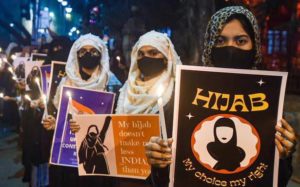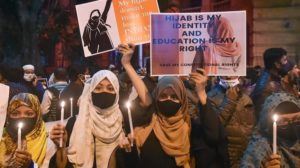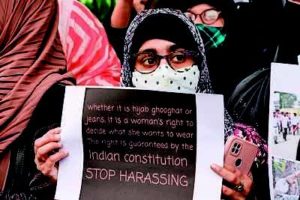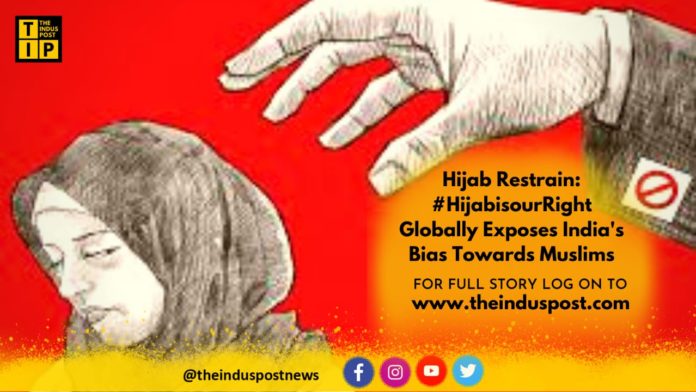Debates are being held globally about minority and women rights. Feminists across the globe are calling for recognition of minority rights and respecting personal choices.
While India has jumped in to advocate for the minority rights on the global level, recent events in the country are totally in contrast with the image portrayed to the world. A wave of communalism has taken over even secularist states in India, where religious minorities are being subject to alienation and violence.
Women belonging to the minority communities have become the latest targets of this rightwing communal politics. While the recent violence has been random, but widespread, it is increasingly taking a structured form and entering institutions of employment and education. The infamous ‘hijab’ row at the southern end of the country is a loud and clear reflection of the same. The objection to hijab in educational institutions is the product of the same structural and communal violence wrapped in ‘patriarchal and religious symbols’.
Even if one turns a blind eye to the core of this violence and believes the larger narrative of the issue, ban on hijab is still unacceptable. Dissecting the popular narrative, two things emerge. First, the educational institutes are no places to practice religion. If this is the case, shouldn’t a Chief Minister be stopped from practicing religion and displaying religious symbols in his official capacity? Shouldn’t this then be applicable to all religious symbols, including turbans, bindi, sindoor and mangalsutra?
Dissecting the popular narrative, two things emerge. First, the educational institutes are no places to practice religion. If this is the case, shouldn’t a Chief Minister be stopped from practicing religion and displaying religious symbols in his official capacity? Shouldn’t this then be applicable to all religious symbols, including turbans, bindi, sindoor and mangalsutra?
Religion is an intrinsic part of identity, therefore, right to practice religion is a basic human right guaranteed to every single person in any sovereign and secular country. The basis of the constitutional foundation of India itself grants the minorities the right to practice religion, nullifying the first narrative. Second, hijab is a patriarchal symbol that curtails women’s rights and should be opposed to liberate women. Although this reason sounds noble, it is all but noble. This reason is a product of a preconceived notion about Islam and holds no truth. Even if one is to believe it, shouldn’t the majoritarian patriarchal practices, including those in Hinduism be banned first? Shouldn’t the country get rid of ‘period huts’ first?
If one looks at the current debates on the ban, Indians seem to be divided over the issue. Some feel the subject is out of state intervention, while others approve of the move due to ill interpretation of Islam.
Certainly, it is not their fault. I believe Muslims have failed to reflect the Islamic concepts to the world, especially that of hijab. While the liberals largely believe that Islam curtails women’s rights, it fails to acknowledge that Islam came at a time when the girl child used to be buried alive. In those darkest of times, Islam guaranteed life and protection to women, advocated educational and property rights and granted them a position of privilege. At times, when public spaces where completely a male domain, Islam introduced hijab to increase women participation in these spaces. Hijab was introduced not to cage women, but to give her wings.
For the unversed, hijab is not a symbol of patriarchy. Like women, men are obligated to observe hijab, just that it is not identical to the one for women. Islam has made hijab an obligation, not a choice.
Those who observe it do it out of love for their religion and God.
Hijab was introduced to limit the objectification of women which is exactly what many feminists out there strive for. It is to empower women, not to oppress them.
In a misogynist and deeply patriarchal society like India, hijab gives women an agency to fight objectification, exercise right to privacy and assert her identity. Same is true for millions of Muslim women fighting the hijab ban in India.
If feminists oppose hijab, saying it has been forced on women, shouldn’t they oppose the ban on it too? Critical theories, including feminism, stand on the mantra that ‘no one size fits all’ and call for respect and acceptance of choices. The same is needed while dealing with the hijab row in India.
Those calling for a ban on the hijab need to understand that it is not only the violation of basic human rights of Muslim women guaranteed under the Indian constitution, but also an attempt to stigmatize and marginalize Muslim women and girls. The discriminatory ban is an assault on the constitutional base of India rather than on its 200 million Muslims alone.
Disclaimer: The views expressed in the article are solely the author’s and does not reflect the opinions of the website or its affiliates.
















